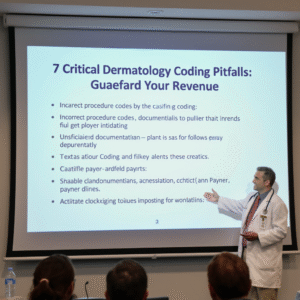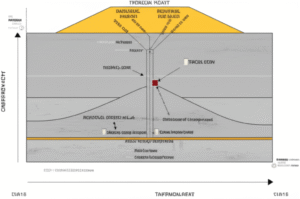The Impact of Medical Coding on Practice Profitability
Medical Coding
Medical Coding
In today’s complex healthcare landscape, medical practices face mounting pressure to optimize their financial performance while maintaining high-quality patient care. Among the many factors that influence a practice’s bottom line, medical coding stands out as one of the most critical yet often underestimated elements. The accuracy, efficiency, and strategic implementation of medical coding processes can make the difference between a thriving practice and one struggling to stay afloat financially.

Medical coding serves as the bridge between clinical care and financial reimbursement, translating the complex language of medical diagnoses, procedures, and services into standardized codes that insurance companies and government payers use to determine compensation. This seemingly technical process has far-reaching implications for practice profitability, affecting everything from cash flow and revenue cycle management to compliance and long-term financial sustainability.
Understanding the Foundation: What is Medical Coding?
Medical coding is the process of converting healthcare diagnoses, procedures, medical services, and equipment into universal medical alphanumeric codes. These codes are derived from medical record documentation, such as physician’s notes, laboratory and radiologic results, and other sources. The primary coding systems used in the United States include the International Classification of Diseases (ICD-10) for diagnoses, Current Procedural Terminology (CPT) codes for procedures and services, and Healthcare Common Procedure Coding System (HCPCS) for supplies and equipment.
The coding process begins when a healthcare provider delivers services to a patient. The clinical documentation created during this encounter must be translated into appropriate codes that accurately reflect the complexity and nature of the services provided. These codes are then submitted to insurance companies, Medicare, Medicaid, and other payers as part of the claim submission process. The accuracy and completeness of this coding directly impact how much and how quickly the practice gets paid.
The Direct Financial Impact of Accurate Medical Coding
The most immediate way medical coding affects practice profitability is through its impact on reimbursement rates and claim approval percentages. Accurate coding ensures that practices receive the full compensation they’re entitled to for the services they provide. When coding is precise and comprehensive, it captures the true complexity of patient encounters, leading to appropriate reimbursement levels.

Consider a common scenario in primary care: a patient presents with multiple chronic conditions during a routine visit. If the coder only captures the primary diagnosis and fails to document secondary conditions that require ongoing management, the practice may receive reimbursement for a simple office visit rather than a complex encounter involving multiple disease management. This coding gap can result in significant revenue loss over time, particularly for practices that frequently manage complex, multi-morbid patients.
The financial impact becomes even more pronounced in specialty practices where procedure codes can vary dramatically in reimbursement value. A cardiac surgeon whose coding team fails to capture all components of a complex procedure or doesn’t document the appropriate level of difficulty may lose thousands of dollars on a single case. These losses compound quickly, making the difference between a profitable quarter and a financial shortfall.
Revenue Cycle Optimization Through Strategic Coding
Medical coding plays a pivotal role in revenue cycle management, the process by which healthcare practices capture revenue for services provided. Efficient coding practices can significantly accelerate cash flow by reducing the time between service delivery and payment receipt. When claims are coded accurately the first time, they’re more likely to be processed quickly by payers, leading to faster reimbursement.
Conversely, coding errors create bottlenecks in the revenue cycle. Claims with coding mistakes are often rejected or denied, requiring time-consuming resubmission processes. Each denial or rejection delays payment and requires additional administrative resources to resolve. The cost of reworking claims, combined with the delayed cash flow, can severely impact practice profitability.

Forward-thinking practices implement coding quality assurance programs that catch errors before claims are submitted. These programs typically involve regular audits of coded claims, ongoing education for coding staff, and the use of technology solutions that flag potential coding errors. While these initiatives require upfront investment, they typically generate significant returns through improved first-pass claim acceptance rates and reduced administrative overhead.
The Hidden Costs of Coding Errors
Beyond the obvious impact of lost revenue from denied claims, coding errors create several hidden costs that can erode practice profitability. Administrative staff must spend time investigating denials, researching proper codes, and resubmitting claims. This process diverts human resources from other revenue-generating activities and increases operational costs.
Coding errors can also trigger payer audits, which are both time-consuming and potentially costly. When payers identify patterns of coding errors, they may conduct comprehensive reviews of a practice’s billing history, potentially leading to recoupment demands for previously paid claims. The administrative burden of responding to audits, combined with the risk of having to repay substantial amounts, represents a significant financial threat to practices with poor coding practices.
Furthermore, systematic coding errors can damage relationships with payers, leading to increased scrutiny of future claims and potentially slower payment processing. Some payers maintain provider performance scorecards that track coding accuracy and claim processing metrics. Practices with poor scores may face additional administrative hurdles or reduced reimbursement rates.
Compliance and Legal Considerations
Medical coding accuracy is not just about maximizing revenue; it’s also about maintaining compliance with federal and state regulations. Incorrect coding can result in allegations of fraud or abuse, leading to severe financial penalties and legal consequences. The False Claims Act imposes significant penalties for submitting inaccurate claims to government payers, with fines potentially reaching tens of thousands of dollars per violation.
Practices must balance the desire to maximize reimbursement with the need to maintain coding accuracy and compliance. This balance requires ongoing education, regular auditing, and a culture of ethical billing practices. Investing in compliance programs may seem like an expense, but it’s actually a crucial form of insurance against much larger potential losses.
The Office of Inspector General (OIG) regularly publishes guidance on proper coding practices and frequently audited areas. Practices that stay current with these guidelines and implement appropriate safeguards are better positioned to avoid compliance issues that could devastate their financial position.
Technology’s Role in Coding Efficiency and Accuracy
Modern medical practices increasingly rely on technology solutions to improve coding accuracy and efficiency. Electronic Health Records (EHR) systems often include built-in coding assistance tools that suggest appropriate codes based on clinical documentation. Computer-Assisted Coding (CAC) systems use natural language processing to analyze physician notes and recommend codes, reducing the manual effort required from coding staff.

These technology investments can yield substantial returns on investment through improved coding accuracy, reduced processing time, and decreased staffing requirements. However, practices must carefully evaluate these solutions to ensure they align with their specific needs and workflows. The most expensive system isn’t necessarily the best fit for every practice.
Artificial intelligence and machine learning are beginning to play larger roles in medical coding, with some systems capable of learning from coding patterns and improving accuracy over time. While these advanced systems require significant investment, they may provide competitive advantages for practices that implement them effectively.
Staffing and Training Considerations
The quality of a practice’s coding depends heavily on the skills and knowledge of its coding staff. Certified coders typically command higher salaries than non-certified staff, but their expertise often more than pays for itself through improved coding accuracy and efficiency. Practices must weigh the cost of hiring experienced, certified coders against the potential losses from coding errors made by less qualified staff.
Ongoing education is crucial for coding staff, as coding guidelines and regulations change frequently. The transition from ICD-9 to ICD-10, for example, required extensive retraining and represented a significant investment for practices. However, practices that invested adequately in training during this transition were better positioned to maintain coding accuracy and avoid revenue disruptions.
Some practices choose to outsource their coding functions to specialized companies that can provide expertise and economies of scale. While outsourcing eliminates the need for in-house coding staff, practices must carefully manage these relationships to ensure quality and maintain compliance oversight.
Measuring and Monitoring Coding Performance
Successful practices implement comprehensive metrics to monitor their coding performance and its impact on profitability. Key performance indicators might include first-pass claim acceptance rates, average time from service to payment, coding accuracy percentages, and revenue per encounter. Regular monitoring of these metrics allows practices to identify trends and address issues before they significantly impact financial performance.
Benchmarking against industry standards and peer practices can provide valuable insights into coding performance. Professional organizations and consulting firms often publish benchmark data that practices can use to evaluate their performance and identify improvement opportunities.
Regular internal audits of coding practices can help identify training needs, process improvements, and potential compliance issues. These audits should be conducted by qualified individuals who can assess both coding accuracy and the adequacy of supporting documentation.
Future Trends and Considerations
The healthcare industry continues to evolve, with new payment models and regulatory requirements that will impact medical coding practices. Value-based care arrangements, for example, require different approaches to coding and documentation than traditional fee-for-service models. Practices must stay ahead of these trends to maintain profitability in changing market conditions.

The increasing focus on social determinants of health and patient outcomes may lead to new coding requirements that capture non-medical factors affecting patient care. Practices that proactively adapt to these changes will be better positioned to succeed under future payment models.
Telehealth services, which expanded dramatically during the COVID-19 pandemic, present unique coding challenges and opportunities. Practices must understand the specific requirements for coding telehealth encounters to ensure appropriate reimbursement while maintaining compliance.
Conclusion
Medical coding represents far more than a back-office administrative function; it’s a critical component of practice profitability that deserves strategic attention and investment. Practices that prioritize coding accuracy, efficiency, and compliance are better positioned to maximize revenue, minimize costs, and maintain financial sustainability in an increasingly challenging healthcare environment.
The impact of medical coding on practice profitability extends beyond immediate revenue effects to encompass cash flow management, compliance risk mitigation, and operational efficiency. By investing in qualified staff, appropriate technology, ongoing education, and robust quality assurance processes, practices can transform their coding operations from a cost center into a significant driver of financial success.
As the healthcare landscape continues to evolve, practices that maintain excellence in medical coding will have a competitive advantage in capturing appropriate reimbursement, managing compliance risks, and adapting to new payment models. The practices that thrive in the future will be those that recognize medical coding as a strategic asset worthy of careful attention and continued investment.



